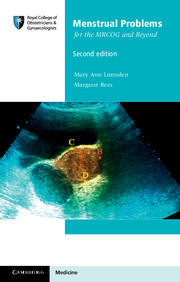47 results
Subjective aging: factors influencing individuals’ perspectives: Commentary on “The paradox of subjective age: age(ing) in the self-presentation of older adults” by Okun et al.
-
- Journal:
- International Psychogeriatrics / Volume 35 / Issue 10 / October 2023
- Published online by Cambridge University Press:
- 06 December 2022, pp. 541-544
-
- Article
- Export citation

Menstrual Problems for the MRCOG and Beyond
-
- Published online:
- 05 June 2014
- Print publication:
- 27 February 2014
7 - Dysmenorrhoea
-
- Book:
- Menstrual Problems for the MRCOG and Beyond
- Published online:
- 05 June 2014
- Print publication:
- 27 February 2014, pp 83-90
-
- Chapter
- Export citation
Series page
-
- Book:
- Menstrual Problems for the MRCOG and Beyond
- Published online:
- 05 June 2014
- Print publication:
- 27 February 2014, pp ii-ii
-
- Chapter
- Export citation
Preface
-
- Book:
- Menstrual Problems for the MRCOG and Beyond
- Published online:
- 05 June 2014
- Print publication:
- 27 February 2014, pp ix-x
-
- Chapter
- Export citation
4 - Medical management of excessive menstrual bleeding
-
- Book:
- Menstrual Problems for the MRCOG and Beyond
- Published online:
- 05 June 2014
- Print publication:
- 27 February 2014, pp 37-46
-
- Chapter
- Export citation
5 - Surgical management of menstrual problems
-
- Book:
- Menstrual Problems for the MRCOG and Beyond
- Published online:
- 05 June 2014
- Print publication:
- 27 February 2014, pp 47-68
-
- Chapter
- Export citation
13 - Premenstrual syndrome
-
- Book:
- Menstrual Problems for the MRCOG and Beyond
- Published online:
- 05 June 2014
- Print publication:
- 27 February 2014, pp 139-146
-
- Chapter
- Export citation
3 - Investigation
-
- Book:
- Menstrual Problems for the MRCOG and Beyond
- Published online:
- 05 June 2014
- Print publication:
- 27 February 2014, pp 17-36
-
- Chapter
- Export citation
12 - Polycystic ovary syndrome
-
- Book:
- Menstrual Problems for the MRCOG and Beyond
- Published online:
- 05 June 2014
- Print publication:
- 27 February 2014, pp 129-138
-
- Chapter
- Export citation
Abbreviations
-
- Book:
- Menstrual Problems for the MRCOG and Beyond
- Published online:
- 05 June 2014
- Print publication:
- 27 February 2014, pp vi-viii
-
- Chapter
- Export citation
2 - Excessive menstrual bleeding
-
- Book:
- Menstrual Problems for the MRCOG and Beyond
- Published online:
- 05 June 2014
- Print publication:
- 27 February 2014, pp 7-16
-
- Chapter
- Export citation
9 - Chronic pelvic pain
-
- Book:
- Menstrual Problems for the MRCOG and Beyond
- Published online:
- 05 June 2014
- Print publication:
- 27 February 2014, pp 103-114
-
- Chapter
- Export citation
10 - Delayed menarche
-
- Book:
- Menstrual Problems for the MRCOG and Beyond
- Published online:
- 05 June 2014
- Print publication:
- 27 February 2014, pp 115-118
-
- Chapter
- Export citation
Editors
-
-
- Book:
- Menstrual Problems for the MRCOG and Beyond
- Published online:
- 05 June 2014
- Print publication:
- 27 February 2014, pp xi-xi
-
- Chapter
- Export citation
Index
-
- Book:
- Menstrual Problems for the MRCOG and Beyond
- Published online:
- 05 June 2014
- Print publication:
- 27 February 2014, pp 147-153
-
- Chapter
- Export citation
6 - Uterine fibroids and heavy menstrual bleeding
-
- Book:
- Menstrual Problems for the MRCOG and Beyond
- Published online:
- 05 June 2014
- Print publication:
- 27 February 2014, pp 69-82
-
- Chapter
- Export citation
Menstrual Problems for the MRCOG and Beyond - Half title page
-
- Book:
- Menstrual Problems for the MRCOG and Beyond
- Published online:
- 05 June 2014
- Print publication:
- 27 February 2014, pp i-i
-
- Chapter
- Export citation
Copyright page
-
- Book:
- Menstrual Problems for the MRCOG and Beyond
- Published online:
- 05 June 2014
- Print publication:
- 27 February 2014, pp iv-iv
-
- Chapter
- Export citation
Menstrual Problems for the MRCOG and Beyond - Title page
-
-
- Book:
- Menstrual Problems for the MRCOG and Beyond
- Published online:
- 05 June 2014
- Print publication:
- 27 February 2014, pp iii-iii
-
- Chapter
- Export citation

